AMD's Radeon HD 5870: Bringing About the Next Generation Of GPUs
by Ryan Smith on September 23, 2009 9:00 AM EST- Posted in
- GPUs
Cypress: What’s New
With our refresher out of the way, let’s discuss what’s new in Cypress.
Starting at the SPU level, AMD has added a number of new hardware instructions to the SPUs and sped up the execution of other instruction, both in order to improve performance and to meet the requirements of various APIs. Among these changes are that some dot products have been reduced to single-cycle computation when they were previously multi-cycle affairs. DirectX 11 required operations such as bit count, insert, and extract have also been added. Furthermore denormal numbers have received some much-needed attention, and can now be handled at full speed.
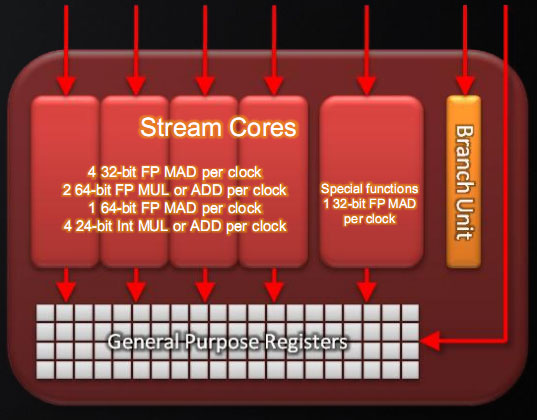
Perhaps the most interesting instruction added however is an instruction for Sum of Absolute Differences (SAD). SAD is an instruction of great importance in video encoding and computer vision due to its use in motion estimation, and on the RV770 the lack of a native instruction requires emulating it in no less than 12 instructions. By adding a native SAD instruction, the time to compute a SAD has been reduced to a single clock cycle, and AMD believes that it will result in a significant (>2x) speedup in video encoding.
The clincher however is that SAD not an instruction that’s part of either DirectX 11 or OpenCL, meaning DirectX programs can’t call for it, and from the perspective of OpenCL it’s an extension. However these APIs leave the hardware open to do what it wants to, so AMD’s compiler can still use the instruction, it just has to know where to use it. By identifying the aforementioned long version of a SAD in code it’s fed, the compiler can replace that code with the native SAD, offering the native SAD speedup to any program in spite of the fact that it can’t directly call the SAD. Cool, isn’t it?
Last, here is a breakdown of what a single Cypress SP can do in a single clock cycle:
- 4 32-bit FP MAD per clock
- 2 64-bit FP MUL or ADD per clock
- 1 64-bit FP MAD per clock
- 4 24-bit Int MUL or ADD per clock
- SFU : 1 32-bit FP MAD per clock
Moving up the hierarchy, the next thing we have is the SIMD. Beyond the improvements in the SPs, the L1 texture cache located here has seen an improvement in speed. It’s now capable of fetching texture data at a blistering 1TB/sec. The actual size of the L1 texture cache has stayed at 16KB. Meanwhile a separate L1 cache has been added to the SIMDs for computational work, this one measuring 8KB. Also improving the computational performance of the SIMDs is the doubling of the local data share attached to each SIMD, which is now 32KB.
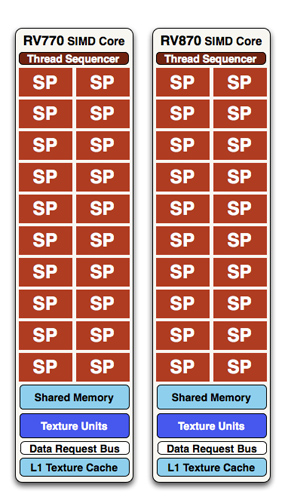
At a high level, the RV770 and Cypress SIMDs look very similar
The texture units located here have also been reworked. The first of these changes are that they can now read compressed AA color buffers, to better make use of the bandwidth they have. The second change to the texture units is to improve their interpolation speed by not doing interpolation. Interpolation has been moved to the SPs (this is part of DX11’s new Pull Model) which is much faster than having the texture unit do the job. The result is that a texture unit Cypress has a greater effective fillrate than one under RV770, and this will show up under synthetic tests in particular where the load-it and forget-it nature of the tests left RV770 interpolation bound. AMD’s specifications call for 68 billion bilinear filtered texels per second, a product of the improved texture units and the improved bandwidth to them.
Finally, if we move up another level, here is where we see the cause of the majority of Cypress’s performance advantage over RV770. AMD has doubled the number of SIMDs, moving from 10 to 20. This means twice the number of SPs and twice the number of texture units; in fact just about every statistic that has doubled between RV770 and Cypress is a result of doubling the SIMDs. It’s simple in concept, but as the SIMDs contain the most important units, it’s quite effective in boosting performance.
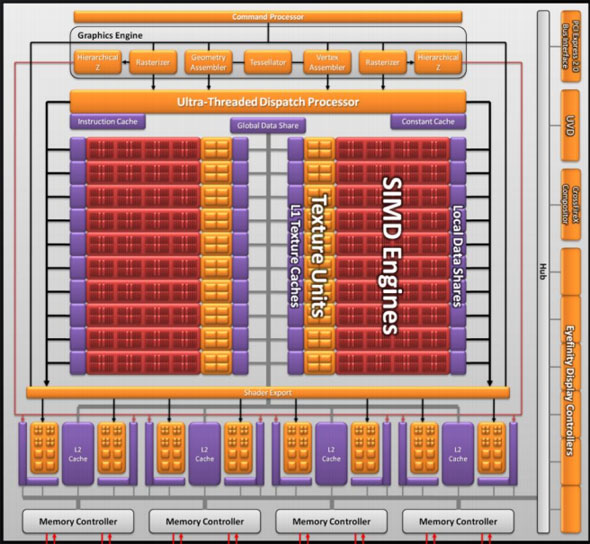
However with twice as many SIMDs, there comes a need to feed these additional SIMDs, and to do something with their products. To achieve this, the 4 L2 caches have been doubled from 64KB to 128KB. These large L2 caches can now feed data to L1 caches at 435GB/sec, up from 384GB/sec in RV770. Along with this the global data share has been quadrupled to 64KB.
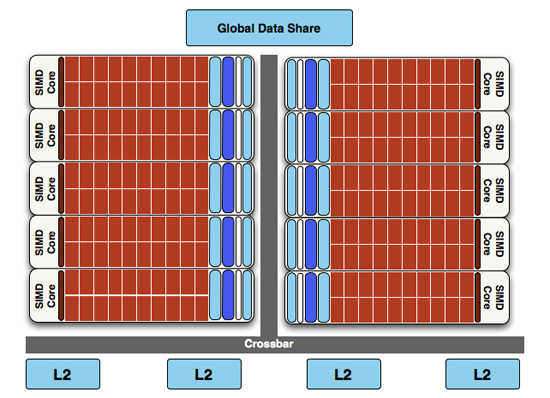
RV770 vs...
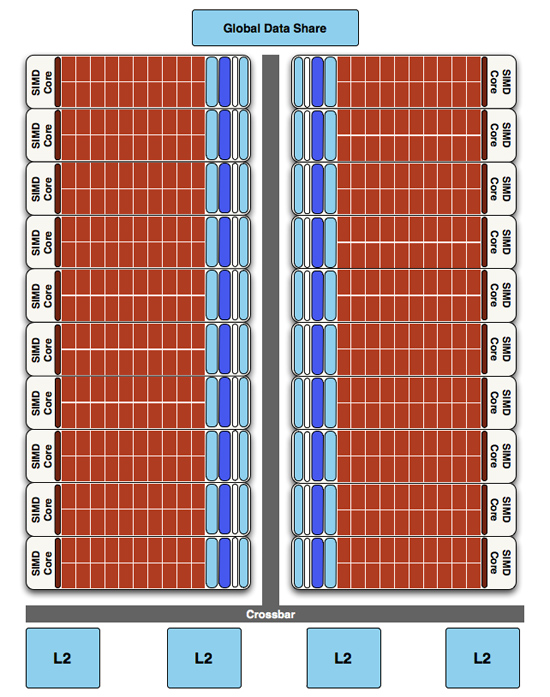
Cypress
Next up, the ROPs have been doubled in order to meet the needs of processing data from all of those SIMDs. This brings Cypress to 32 ROPs. The ROPs themselves have also been slightly enhanced to improve their performance; they can now perform fast color clears, as it turns out some games were doing this hundreds of times between frames. They are also responsible for handling some aspects of AMD’s re-introduced Supersampling Anti-Aliasing mode, which we will get to later.

Last, but certainly not least, we have the changes to what AMD calls the “graphics engine”, primarily to bring it into compliance with DX11. RV770’s greatly underutilized tessellator has been upgraded to full DX11 compliance, giving it Hull Shader and Domain Shader capabilities, along with using a newer algorithm to reduce tessellation artifacts. A second rasterizer has also been added, ostensibly to feed the beast that is the 20 SIMDs.










327 Comments
View All Comments
SiliconDoc - Sunday, September 27, 2009 - link
I'll be watching you for the very same conclusion when NVidia launches soft and paper.I'll bet ten thousand bucks you don't say it.
I'll bet a duplicate amount you're a red rager fan, otherwise YOU'D BE HONEST, NOT HOSTILE !
rennya - Thursday, September 24, 2009 - link
It may be paper-launch in the US, but here somewhere in South East Asia I can already grab a Powercolor 5870 1GB if I so desire. Powercolor is quite aggresive here promoting their ATI 5xxx wares just like Sapphire does when the 4xxx series comes out.SiliconDoc - Thursday, September 24, 2009 - link
I believe you. I've also seen various flavors of cards not available here in the USA, banned by the import export deals and global market and manufacturer and vendor controls and the powers that be, and it doesn't surprise me when it goes the other way.Congratulations on actually having a non fake launch.
Spoelie - Wednesday, September 23, 2009 - link
"The engine allows for complete hardware offload of all H.264, MPEG-2 and VC1 decoding".This has afaik never been true for any previous card of ATi, and I doubt it has been tested to be true this time as well.
I have detailed this problem several times before in the comment section and never got a reply, so I'll summarize: ATi's UVD only decodes level 4 AVC (i.e. bluray) streams, if you have a stream with >4 reference frames, you're out of luck. NVIDIA does not have this limitation.
lopri - Wednesday, September 23, 2009 - link
Yeah and my GTX 280 has to run full throttle (3D frequency) just to play a 720p content and temp climbs the same as if it were a 3D game. Yeah it can decode some *underground* clips from Japan, big deal. Oh and it does that for only H.264. No VC-1 love there. I am sure you'd think that is not a big deal, but the same applies to those funky clips with 13+ reference frames. Not a big deal. Especially when AMD can decode all 3 major codecs effortlessly (performance 2D frequency instead of 3D frequency)rennya - Thursday, September 24, 2009 - link
G98 GPUs (like 8400GS discrete or 9400 chipset) or GT220/G210 can also do MPEG2/VC-1/AVC video decoding.The GPU doesn't have to run full throttle either, as long as you stick to the 18x.xx drivers.
SJD - Wednesday, September 23, 2009 - link
Ryan,Great article, but there is an inconsistancy. You say that thanks to there only being 2 TDMS controllers, you can't use both DVI connectors at the same time as the HDMI output for three displays, but then go onto say later that you can use the DVI(x2), DP and HDMI in any combination to drive 3 displays. Which is correct?
Also, can you play HDCP protected content (a Blu-Ray disc for example) over a panel connected to a Display Port connector?
Otherwise, thanks for the review!
Ryan Smith - Wednesday, September 23, 2009 - link
It's the former that is correct: you can only drive two TDMS devices. The article has been corrected.And DP supports HDCP, so yes, protected content will play over DP.
SJD - Friday, September 25, 2009 - link
Thanks for clarifying that Ryan - It confirms what I thought.. :-)chowmanga - Wednesday, September 23, 2009 - link
I'd like to see a benchmark using an amd cpu. I think it was the Athlon II 620 article that pointed out how Nvidia hardware ran better on AMD cpus and AMD/ATI cards ran better on Intel cpus. It would be interesting to see if the 5870 stacks up against Nv's current gen with other setups.